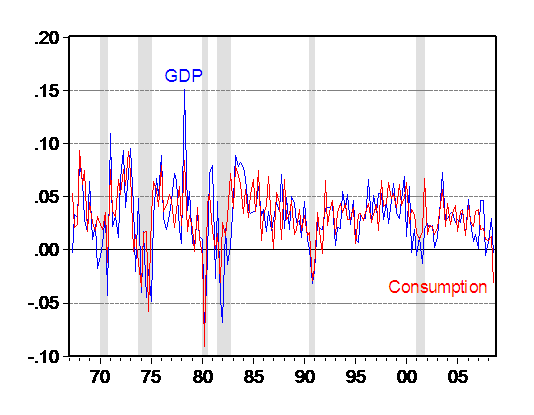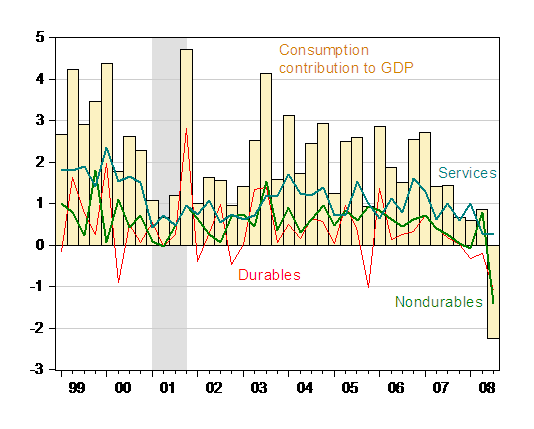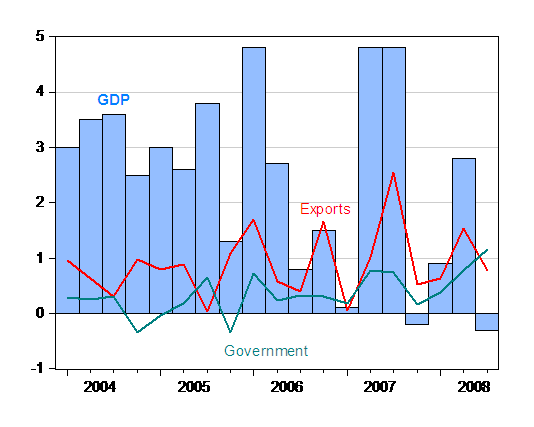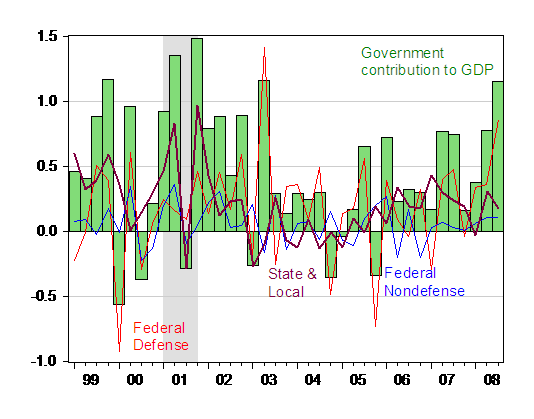If you went no further than noticing that the q/q annualized growth rate of -0.3% was faster than the -0.5 in the Bloomberg consensus, you might have taken this as good news. I’m not going to say it wasn’t good news (relatively speaking), although negative growth makes the case for recession pretty good according to Jeff Frankel (who is on the NBER BCDC); see also RealTime Economics. However, there are some pretty interesting things that merit additional discussion.
I think that most observers will concur with assertion that the -3.1% decline in consumption q/q annualized was the most important aspect, as highlighted in Jim’s post. To place the consumption drop in perspective, consider the q/q changes in GDP and consumption over the last forty years. The last time consumption growth went negative was in the 1990-91 recession. Figure 1 show the growth rates (not contributions to GDP).

Figure 1: Quarter-on-quarter annualized growth rates of real GDP (blue) and consumption (red), calculated as log-differences. NBER defined recession dates shaded gray. Source: BEA, NIPA release of 30 October 2008, NBER, and author’s calculations.
What is the composition of this consumption decline? Figure 2 shows the contribution of each consumption aggregate to GDP growth. It’s apparent that the consumption decline is widespread, spanning all categories. Durables I expected to decline, given the procyclicality of consumer durable expenditures. The decline in services and nondurables, however, signals either more binding credit constraints, a downward revision in permanent income, or both.

Figure 2: Consumption contribution to GDP growth (tan bars), durables contribution (red), non-durables contribution (green) and services contribution (teal), in percentage points. NBER defined recession dates shaded gray. Source: BEA, NIPA release of 30 October 2008 and NBER.
Returning to overall growth, I have two observations that pertain to growth prospects. The first is that exports are accounting for a smaller proportion of overall growth — and no longer sufficient to keep growth positive, obviously. With the slowdown going global [1], there will be even less support from this channel. I’ll also add a speculative note; it might be the case that the credit crunch impacted negatively international trade, in particular exports, in September, and even more substantially going forward [2]. We’ll find out more in a couple weeks when the September trade figures are released. Second, government spending is the single largest aggregate category in GDP growth, at 1.15 percentage points of the -0.3 percentage points total.

Figure 3: GDP growth (blue bars), exports contribution (red), and government contribution (teal), in percentage points. NBER defined recession dates shaded gray. Source: BEA, NIPA release of 30 October 2008 and NBER.
Figure 4 illustrates the breakdown of contributions from government spending.

Figure 4: Government contribution to GDP growth (green bars), Federal nondefense contribution (blue), Federal defense contribution (red) and State and Local contribution (purple), in percentage points. NBER defined recession dates shaded gray. Source: BEA, NIPA release of 30 October 2008 and NBER.
In the government sector, defense is providing the bulk of the growth: 0.86 ppts of overall growth. It would be interesting to find out what this spending is on. Another observation is that state and local spending is accounting for a smaller share of growth. This reflects the increasingly binding constraints on spending imposed by declining tax revenues — validating the assertion I made in this post several months ago about the inability of state and local spending to maintain growth.
A couple of the requisite caveats. Justin Fox reminds us that the deflators — particularly consumption deflators — appear a bit dubious. Revisions in the deflators will induce revisions to real magnitudes.
Looking further ahead, Nouriel Roubini argued in today’s JEC panel that when the final final revision of the GDP data is in, negative growth will have started at end-2007 as the 08H1 data are revised downward. To me, a pretty plausible possibility, given the data revisions that occurred around the last recession. [3], [4].
In any case, no reason to modify the view that this particular recession will be very deep, reinforcing the case for effective fiscal stimulus.
See also: WSJ.
Technorati Tags: recession, consumption,
government spending, defense spending,
and fiscal stimulus.
So we are in a ‘WW2 type-depression’ with only war/defence spending currently keeping growth going in the US.
I have no quarrel with your argument, but you need to realize that your first graph (GDP and consumer spend) is simply unreadable visually as are all QoQ graphs over many years. Supplementing it with a simple correlation coefficient or something like that would have helped reinforce the point. Actually, even using a smoothing algorythm or showing a HYoHY graph would be better.
Thank you for this excellent blog.
Question: did you think the Government growth of 1%+ essentially automatic stablisation kicking in or lagged increases in budgets?
I urge all who write on matters macro to stop using the silly “negative growth” locution. We actually have words which express the same notion directly, with no need to use a happy word and slap a negative on the front. The economy is contracting. GDP is falling. “Banana” would be better.
RJM,
As our host points out, most of the rise in government spending was on military stuff. Military stuff isn’t among our automatic stabilizers. Non-military federal government spending was steady at a 0.11% contribution to GDP, same as in Q2. Those were the two highest readings in some time and may show a bit of the automatic stabilizer mechanism.
State and local spending – including jobless benefits, food stamps and the like? – made a smaller contribution in Q3 than Q2. Among recent quarters, only Q1 showed a smaller contribution from state and local spending to overall growth than Q3. Doesn’t look like automatic stabilizers account for much in Q3. That’s unfortunate.
There really isn’t that much difference between a -0.3% and -0.5%, particularly since the numbers will go through revisions. Also, the Blue Chip consensus from earlier this month had predicted -0.3%. It all depends on which/when “consensus” we are talking about.
4degreesnorth: I’ve made the graphs larger. Hopefully that will help make them legible. If you’ve read previous posts, you’ll see why I prefer to present untransformed data (excepting the log transform) unless the transformed data is accompanied by the untransformed (i.e., moving average accompanied by raw data).
RJMacDonald: I think kharris has it right; defense spending is not usually thought of as being used for countercyclical stabilization policy. That’s why I’m curious about why there was this surge in defense spending. Insights welcome.
GWG: I agree there’s not much difference between the varoius consensus estiamtes; I used the Bloomberg consensus because it was listed at a time closest to the release date, so seemed to incorporate the most information. In other words, if one wants to infer the largest “news” component to the announcement, one wants the “time t-1” expectation to be as close as possible to “time t” announcement.
My bet is and has been since 2001 when Greenspan embarked on pre-calculated Real Estate bubble blowing that we will go into a 2nd Great Depression since we didn’t seem to learn the lessons of the 1st one. After all, the Nobel is going to economists like Krugman who believe passing out tickets is the same thing as building the stadium seat. Talk about foolish.
Fiscal stimulus can’t “help” in any way except to forestall a collapse in debt-money (and it’s better to give people a permanent asset like gold with no counterparty risk rather than round-robin the game: spending and then acting as if the value of that spending doesn’t come from the economy in the first place is just Keynesian smoke-and-mirrors).
Upholding consumption certainly is a loser given the problems have been misdirected production and vast over-consumption in the first place.
But then, “upholding consumption” was exactly what was done in the Great Depression, which I assume, could have ended much faster (like all the other credit-induced depressions before it). That’s the benefit of sound economic principles rather than the belief in ‘fairy dust’ of government spending.
Professor, I’d appreciate your analysis on a question that has bothered me for a while and is related to the fiscal stimulus.
Much comparsion has been made between Japan in the 90s and US in the current recession. One big difference is that Japan has a big pool of private savings and runs a trade surplus. In contrast, US has run a huge trade deficit and American households are heavily in debt.
In the case of Japan, the Japanese government could run up big debt financed fiscal stimulus packages (often building bridges leading to nowhere) and still keep the interest rate near zero.
Could US do the same, without the private saving and with a trade deficit? Now that many prominent economists are calling for fiscal stimulus, such money would have to be borrowed, by selling treasuries to foreigners.
Military spending is one of the things the party in power can directly manipulate to assure that there is a surge in growth going into an election.
It might be interesting to look at the history of both parties to see what happens to military spending in the quarters running up to a presidential election.
Thanks for all the responses to my question. Thanks particularly to Prof Menzies and kharris in putting out the prior quarters state and local budget comparisons.
What I was thinking of in asking them is the notion that substantial portions of the Federal deficit have been shifted from sectors relatively sensitive to economic activity to those, which like the military, are not.
A question is, therefore, how long will locked in increases in military budgets persist especially after Tuesday.
A bigger question how sensitive are budgets — especially to current economic activity and to expectations of future activity.
Or are we in a “fiscal trap” with tremendous budget constraints because of military “stuff” as kharris so delicately puts it, just as we will soon be in a liquidity trap on in terms of monetary policy.
In that case, any fiscal stimulus would come too little too late or — even worse too late and too much.
“In any case, no reason to modify the view that this particular recession will be very deep,”
Agreed, on a macro level. Although sectors such as Tech will suffer less than they did in 2001.
But if the recession began in December, and the longest post-GD recession has been 16 months, isn’t it extremely unlikely that this recession will last beyond Q209?
Given that oil is cheap and interest rates are now low, why would there not be a strong GDP recovery by Q209 at the latest?